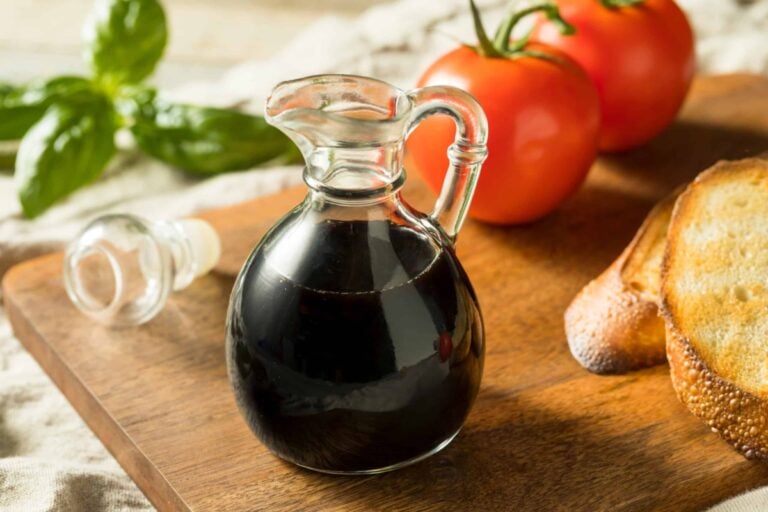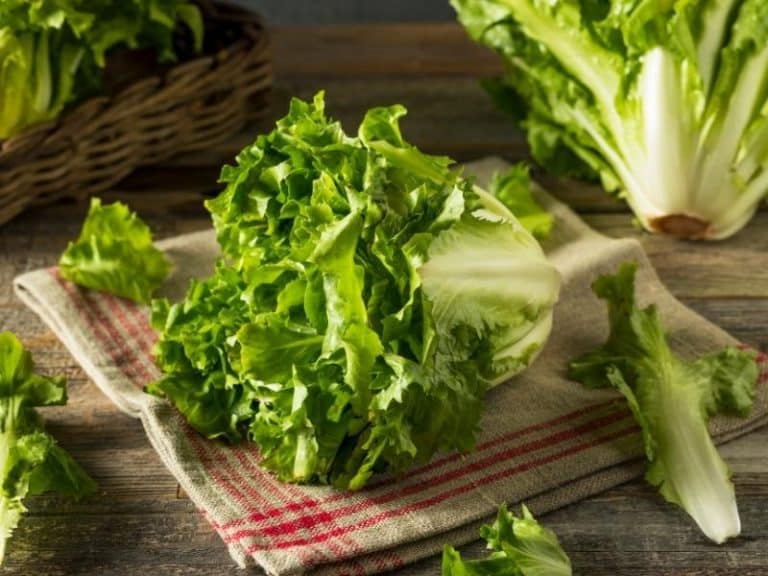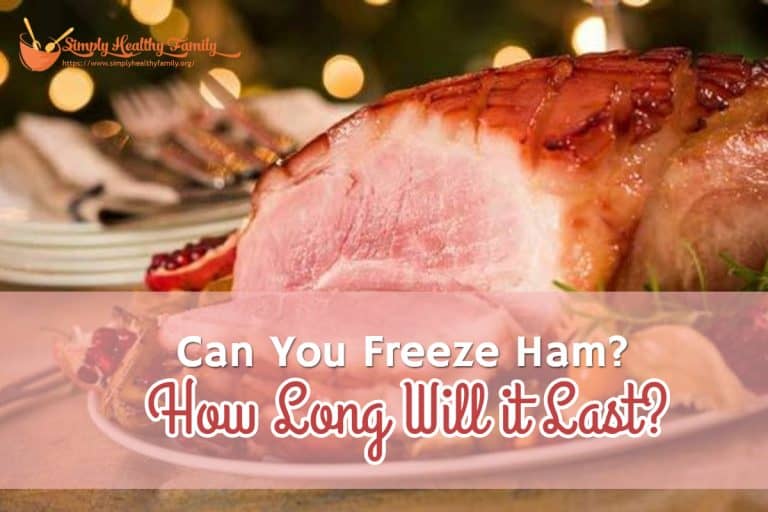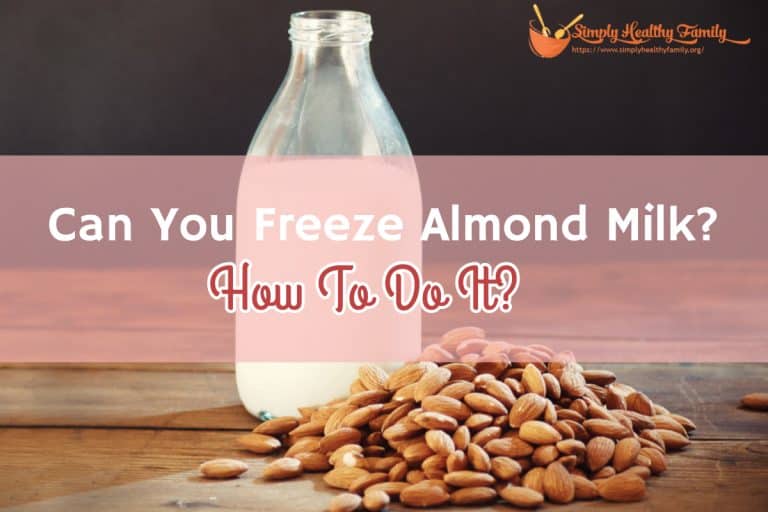Food Before The Harvest: An Overview of Where Our Foods Came From
Being a foodie brings wonders and joy to everyday life. The amount of pleasure generated while enjoying a favorite meal or snack, or discovering something new and exotic is among the best emotions available to man.
Food heals us and binds us together.
Food keeps us alive – literally.
Since the dawn of humanity, our ancestors enjoyed the Mother Nature’s gifts in their primal form.
The industrialization and modernization brought the food processing and improvement in all areas, bringing the final product to our tables. We all enjoy the fruits of this progress, but have you ever wondered, how does your food look like before it’s harvested?
If you did, you’re in for a very interesting ride. Today you’re going to find out some fascinating things and facts, and learn some interesting stuff about your favorite food.
Here at Cook The Stone, we put some serious effort to educate you on this topic and show you some interesting stuff about ten different types of food, which doesn’t look like you’d imagine.
Sesame
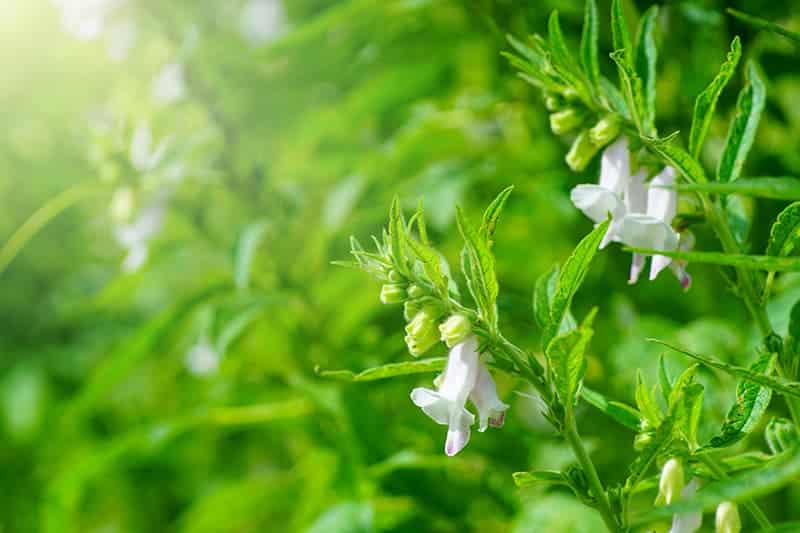
Sesame plant

“Sesame seed is considered to be the oldest oilseed crop known to humanity.”
Ancient Egypt and Indian civilizations are first connected with sesame seed – in the period around 1600 B.C. The hot and dry conditions areas around Sahara desert were still suitable for the durable plant of Sesamumindicum L, which is the sesame seed first classification.
Since the Tomas Jefferson age, sesame has been cultivated and grown. Mostly cultivated in Africa, it was called “beni – benne” back in the day. Sesame was introduced in the US market as a commercial product around 1952, and since then its popularity is on the rise.
When and where sesame seed is harvested?
Because it’s a tropical plant, sesame flourishes during the warm season and performs the best in the warmer climate. Around 150 frost-free days of the year is the period of production season for sesame, and its production cycle usually takes place in that period. The harvest usually takes place in the period between September and December.
India, Sudan, China, Myanmar, and Tanzania are the biggest world’s manufacturers, and the state of Texas takes the majority of sesame crops and manufacturing.
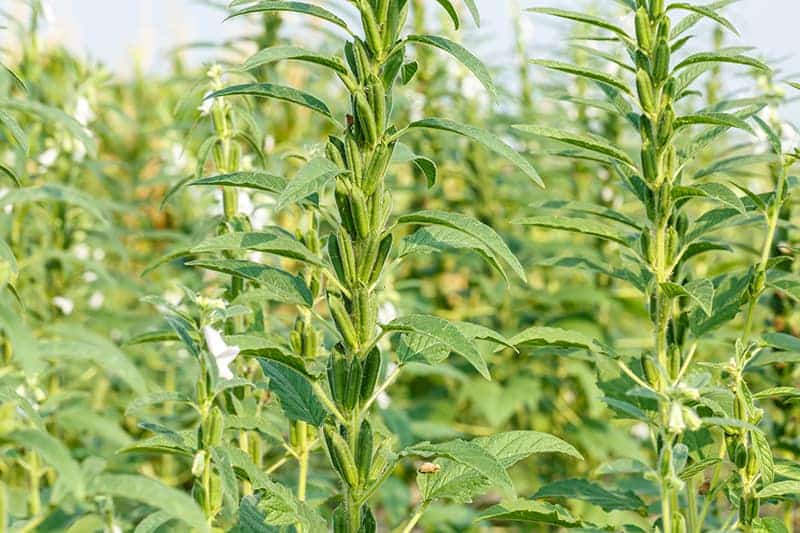
Sesame fruit
What are sesame seeds used for?

White Sesame Seeds
There are dozens of ways to use sesame seeds in nutrition. First and foremost, sesame oil is one of the most utilized oils in cooking worldwide. There are dozens of variables and types of sesame oil produced in the world, each with its distinctive characteristics such as flavor, aroma, viscosity, texture, and ingredients. Sesame oil is among the healthiest on the market, but among the pricier as well.
The sesame seed found usage as a whole seed on various recipes, mostly as a garnish on pastries. In Asian cultures, ground sesame is served on the table just like salt and pepper is in the average US home. Ground sesame is used in many recipes as an addition to pastry mixtures, shakes, cakes, and even drinks. Many small crunchy snacks such as crackers, sticks and the like contain sesame as a healthy addition and substance for salt.
Its oily contents are ranking it among the best seeds for omega fatty acids, therefore putting the sesame seed among the most consumed and utilized seeds in healthy nutrition over many cuisines around the world.
What are differences between white and black sesame seeds?
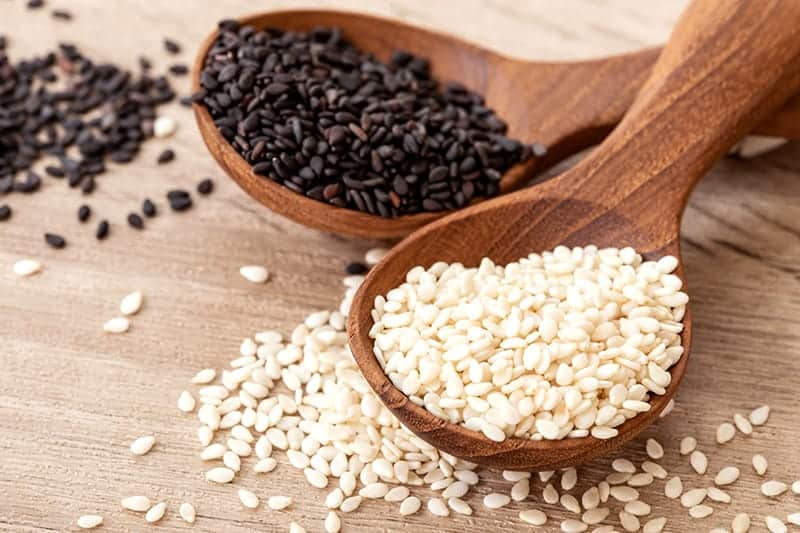
Black and White Sesame Seeds
Besides the obvious color, the distinction between the two types of sesame seeds is mostly in taste and usage. The white seeds have the recognizable sweet/nutty flavor, while black ones have a bit bitter taste, somewhat similar to dark chocolate mixed with coffee.
Both types of sesame have their utilization in the kitchen; white is best used in bread, pastry, sauces & sweets, while black is better utilized in salads, vegetable-based creams and soups, and especially in rice-based meals.
No matter what type of sesame seed you’re about to use, make sure you fry it for 20 seconds in a pan on medium heat. It will unlock the true taste of both.
Both types of sesame are used to produce oil, and depending on the process and additional ingredients involved, you get various types of oil, each with its characteristics and values.
What are sesame seed nutrition values?

Roasted Sesame Seeds
Let’s present the values in a table, for quicker and simpler understanding:
Amount per 100 grams
| |
Value |
% Daily Value* |
|---|---|---|
|
Calories |
573 kcal |
|
|
Total Fat |
50 g |
76% |
|
Saturated fat |
7 g |
35% |
|
Polyunsaturated fat |
22 g |
|
|
Monounsaturated fat |
19 g |
0% |
|
Cholesterol |
0 mg |
0% |
|
Sodium |
11 mg |
0% |
|
Potassium |
468 mg |
13% |
|
Total Carbohydrate |
23 g |
7% |
|
Dietary fiber |
12 g |
48% |
|
Sugar |
0.3 g |
|
|
Protein |
18 g |
36% |
|
Vitamin A |
0% |
|
|
Vitamin C |
0% |
|
|
Calcium |
97% |
|
|
Iron |
81% |
|
|
Vitamin D |
0% |
|
|
Vitamin B-6 |
40% |
|
|
Vitamin B-12 |
0% |
|
|
Magnesium |
87% |
How is sesame seed harvested?

Harvesting Sesame
When the sesame seed pods turn green, the harvesting period can begin. Basically, the harvesting process consists of collecting seed pods, breaking them up gently and releasing seeds from the inside. Here’s how the green sesame seed pods look like:
During the process of harvesting, a lot of care is required to prevent damage to the seeds, since they are very gentle when out of the pods. The raw sesame seed contains around 50% of oil, which makes it prone to damage if handled without care.
Firstly, the stalks with green sesame pods are bundled and dried before seed extraction. This makes the process easier. Leaves are removed from the stalks, and groups of 10-15 stalksare made. Then, bundles are left to dry for a period of time (until the pods turn brown, variable) and then they are crushed to extract the seeds.
Seeds are then cleaned and hulled to reach the end product we’re all used to.
Amazing, don’t you think?
Cranberry

Cranberries

“Cranberry is one of the world’s healthiest foods”
One of the healthiest fruits in the world, cranberry is sour-sweet berry that is perfect for weight loss and healthy lifestyle. They are stacked with antioxidants, which help our bodies fight diseases and strengthen the immunity. Amazingly, cranberries are extremely low incalories and can be a sugar craving solution.
The plants were on the American continent long before the settlers arrived, and Indians used it as a naturally sweet, medicine, and food.
When and where cranberries are harvested?

Cranberries Bushes
Across North America and Canada, millions of pounds of cranberries are harvested in autumn. In spring, growers drain their bogs and marshes making it possible for plants to blossom and bees to pollinate. Next phase happens in summer, mid-July when petals fall off the flowers. This leaves green nodes which are supposed to turn into cranberries.
Leading producers in this region are Wisconsin and Massachusetts.
Harvesting season usually startsmid-September and lasts through mid-November. On the other hand, cranberry fields in Chile and Argentina are harvested from March through May.
In both cases, growers start harvesting when the berries reach the peak of color and flavor. That’s the clear sign of fruit’s ripeness.
What are different methods of harvesting cranberries?

Cranberries Plants
There are two distinct methods of harvesting cranberries: dry and wet harvesting.
Wet harvesting is more common overall; over 90% of crops are harvested this way.This process starts by flooding the bogs. Cranberries have pockets of air inside of the fruit; this is the reason they float up when water is pumped into the fields. After flooding, water reels are used for stirring the water up. This way, berries are separated from their vines, and they start floating on the bog’s surface.
The final step is gathering the berries with wooden or plastic “boom” and lifting them by conveyor or packing them to the truck. From this point, harvested berries are taken to the receiving station for cleaning.
Wet harvested cranberries are used for making juices, sauces or as ingredients for other processed food and for making sweetened dried cranberries.
Dry harvesting can’t be done if there’s any moisture on the plant. After growers pick the right day for collection, they start by walking a mechanical picker trough their fields. These machines comb berries off the vines into the burlap bags.
Growers usually use bog vehicles or helicopters to remove berries from bogs and take them to receiving station to be graded and screened.
Dry harvested berries are less likely to get damaged; this is why they are sold fresh at the markets and stores. They can also be used for cooking and baking.
What are cranberries used for?

Cranberries and Cranberry Juice
Cranberries are best known for their effect in battling the urinary tract infections. They can be used as a prevention and treatment when it comes to these problems.
However, they are efficient if you are struggling with kidney stones, various bladder diseases and difficulties in urination control. Cranberries are also useful for urine catheter blockades prevention, increasing using flow, killing germs and reducing fever.
It’s a different way supplying nutrition compared to drinking watermelon juice, using cranberry juice regularly enhances the amount of salicylic acid in your body, which can potentially prevent blood clots, reduce swelling and have antitumor effects.
Cranberries might even help with many other health problems such as type 2 diabetes, metabolic syndrome, Helicobacter infections, enlarged prostate, heart diseases and chronic fatigue syndrome.
Of course, this berry is commonly used in a kitchen as well. People like using it to make sauces, juices, juice cocktails and jellies.
How to preserve cranberries for a long time?

Cranberries Covered With Frost
Preserving cranberries is completely safe; they can be frozen and stored for several years.
Fresh cranberries purchased already packed in a plastic bag can be directly put in the freezer. Otherwise, they should be washed, drained and separated from leaves and damaged berries.
After this, there commendation is to spread them in a single layer on a baking sheet and freeze them until they are solid. Then, they can be safely packed in plastic bags or container and stored in the freezer.
The good thing is, they can be used in recipes directly from the freezer, after rinsing them in cold water, without the need to thaw them.
What are its nutrition values?

Frozen Cranberries
Amount per 100 grams:
| |
Value |
% Daily Value* |
|---|---|---|
|
Calories |
46 kcal |
|
|
Protein |
0.4 g |
|
|
Carbs |
12.2g |
4% |
|
Sugar |
4 g |
|
|
Fiber |
4.6 g |
16% |
|
Fat |
0.1 g |
0.1% |
|
Saturated |
0.01 g |
0% |
|
Monosaturated |
0.02 g |
|
|
Polisaturated |
0.06 g |
|
|
Omega-3 |
0.02 g |
|
|
Omega-6 |
0.03 g |
|
|
Vitamin A |
3 µg |
0% |
|
Vitamin C |
13.3 mg |
15% |
|
Vitamin E |
1,2 mg |
8% |
|
Vitamin K |
5,1 µg |
4% |
|
Vitamin B1 |
0,01 mg |
1% |
|
Vitamin B2 |
0,02 mg |
2% |
|
Vitamin B3 |
0.1 mg |
1% |
|
Vitamin B5 |
0.3 mg |
6% |
|
Vitamin B6 |
0.06 mg |
4% |
|
Folate |
1 µg |
0% |
|
Choline |
5.5 mg |
1% |
|
Calcium |
8 mg |
1% |
|
Iron |
0.25 mg |
3% |
|
Magnesium |
6 mg |
2% |
|
Phosphorus |
13 mg |
2% |
|
Potassium |
85 mg |
2% |
|
Sodium |
2 mg |
0% |
|
Zinc |
0.1 mg |
1% |
|
Copper |
0.06 mg |
7% |
|
Manganese |
0.36 mg |
16% |
|
Selenium |
0,1 µg |
0% |
Chocolate

Cacao Pod On The Tree
Chocolate comes from cacao pods off of the cacao trees.
People love everything from chocolate, such as chocolate milk or chocolate cookies. Many of them have wished that chocolate grew on trees. Well, they are not far from the truth. The sweet brown miracle which we consume on a daily basis originates from the small tropical tree, called Theobroma Cacao, known as just “cacao.”
Today, cocoa is commercially grown trough the tropics, but its roots are from Central and South America.
Cocoa beans have a pale color and bitter taste. How do they become chocolate at one point? The answer is – through fermentation, drying in the sun and processing in factories. During all of these phases, cocoa develops its dark brown color and rich taste.
When and where are cocoa trees planted?

Cacao Pods
Theobroma Cacao gives pods ready to be harvested only twice a year, in six-month cycles. However, the tree flowers during all 365 days, but only around forty of the thousands of white (male) and pink (female) flowers are bound tobecome cocoa pods eventually.
The youngcocoa tree starts producing cocoa pods when it is five years old. Until that moment, it grows in the shadows of tall plants which protect it from burning equatorial sun and strong wind.
As the tree grows only in a tropical climate, it is not a surprise that it originates from rainforests in Honduras, Venezuela, and Mexico. These countries still hold the largest number of species. Today, the cocoa is grown in the narrow belt (10 degrees latitude) around the equator in America, Asia, and Africa.
East coast of Africa is the largest supplier of commercial cocoa, with Cote D’Ivorie and Ghana holding the 54% of world’s supply.
How does the weather affect the value of cocoa beans?

Red Cacao Pod
Theobroma Cacao trees are extremely sensitive. They require consistent climate: temperatures between 21 and 31°C, never lower than 15°C. They also need between 100 and 250 cm of rainfall, well distributed through the year, with no months having less than 10 cm.
If these conditions are not met, it can drastically affect harvest times and make it more susceptible to various diseases. Changesin the weather cause fluctuations from year to year.
Crops growing out of the shade in direct sunlight and high temperatures will give a greater quantity in short period, but its quality will be low. They tend to accumulate more weeds and catch diseases more quickly. Drought is also one of the factors whichleads to a higher mortality of seed and young trees.
On the other hand, too much rainfall and cold weather can affect the flowering of the cocoa and may cause landslides. Fermentation and drying processes are endangered too, especially with beans being susceptible to mold.
Cocoa beans at the time of harvesting and after fermentation

Cacao Beans In A Pod
What do the cocoa beans and pods look like? Well, their looks change from the moment of harvesting and through the fermentation.
One cocoa pod contains between 20-60 beans surrounded by the sweet white pulp. The pulpmaybe sweet, but the beans are bitter due to a variety of chemicals they contain.
Harvesting the cocoa pods is not an easy job. During the peak of the season,pods need to be gathered every few weeks. It is done by cutting the pods of the tree, carefully, without damaging nearby flowers and buds.
Splitting up the pod after it’s been harvested will show pale beans covered in white pulp or mucilage. Beans are then removed from the pod so that the fermentation can start.
Fermentation is a crucial step, and it lasts approximately seven days. It requires packing the seeds in the boxes or heaping them into piles. These piles are covered with mats or banana leaves.
Covers heat up the surrounding pulp, which starts the fermentation. Once fermentation is finished beans get their brown color and flavor that resembles the chocolate we know.
Then, beans are dried in the sun or using solar dryers. This takes a few days too and further improves the cocoa’s color and flavor.
There are many more steps before dried beans turn into chocolate: after growing, harvesting fermenting and drying comes marketing, packing and transporting, roasting and grinding, pressing and after all that, chocolate making.
Now that you know all of this information, do you appreciate chocolate even more?
Vanilla

Dried Vanilla And An Orchid

“Vanilla is a flavoring derived from orchids of the genus Vanilla.”
It is the second most expensive spice after saffron because growing the vanilla seed pods is labor-intensive. Despite the expense, vanilla is highly valued for its unique flavor.
Flat-leaved Vanilla plant (Vanilla planifolia) from Orchidaceae family is most common, and it is the only orchid used for the industrial food purposes. This climbing plant grows up the trees and can be up to 30 feet long.
Vanilla orchids can’t produce pods until they are pollinated by a humming bird or one particular species of bees from Central America. Additionally, flowers are only opened for a brief period, which means harvesting vanilla is very complicated. This is one of the main reasons why plants grown for the commercial production are usually hand pollinated and their products are so expensive.
What is vanilla used for?

Vanilla Orchid
Vanilla is widely used in both commercial and domestic baking, perfume manufacture and aromatherapy.
In the kitchen, vanilla is usually added as a flavoring, but it can also serve for reducing needed amount of sugar or stopping tooth decay.
Vanilla pod offers a lot of health benefits used for making medicine. It is efficient in treating intestinal gas, reducing fever and increasing sexual desire. It is especially potent in older men. Aphrodisiac effects are one of the reasons it is such a popular fragrance in perfumes.
Vanilla in aromatherapy had proven its calming and respiratory effects. It reduces startle reflex and it is used in candles that help promote peaceful sleep and bath products. Few drops of vanilla solution are supposed to help with breathing problems and sleep apnea.
When and where is vanilla planted?

Vanilla Pods On The Tree
The perfect time for planting vanilla is in autumn when there is neither too much nor too little rain. It is recommended to be done between September and November. However, these recommendations vary with growing conditions.
This plant prefers bright places with indirect sunlight and high humidity. It also requires large amounts of water and hot temperatures.
All of these conditions are naturally provided only in territory 10 to 20 degrees north and south of the equator. The majority of vanilla supply is held by Madagascar and the Island of Réunion. Other big producers are Mexico and Tahiti.
Stages of production:
1.Harvesting
Harvesting vanilla pods is a daily job because each pod ripens in its own time. It takes about nine months from flowering and pollinating for beans to get ready for harvesting. The maturity of the podis is determined by looking for the pale yellow discoloration on the tip of the fruits.
Each and every pod is hand-picked just as it begins to split on end. Green, immature podsare not harvested, while over matured are likely to split and cause a reduction in market value.

Vanilla Pods
2.Curing
There are many methods for curing vanilla on the market such as Mexican method, Tahiti method or Bourbon method, but every one of them includes following steps: killing, sweating, slow-drying, and conditioning the beans.
1
Killing
To stop the growth of vanilla pods and initiate enzymatic reactions responsible for aroma by disrupting the cells and the tissue of the fruit, the pods vegetative tissue needs to be killed. Killing is done by exposing it to direct sunlight, heating it in the oven or hot water, freezing or scratching it. All of these methods provoke different enzymatic activity. If killing is done right, beans should turn brown.
2
Sweating
During this step, killed beansare stored in the boxes lined with woolen blankets or insulation. This retains temperature from 45 to 65°C and high humidity. It promotes desired enzymatic reactions and prevents harmful fermentations. Beans turn deeper brown, and the distinctive aroma becomes perceptible. Dipping fruits in hot water or daily exposure to the sun may also be used.
3
Drying
After the sweating, beans still retain 60-70% of their moisture. This needs to be reduced to 25-30%, using the process of drying. Itis doneto prevent rotting and lock the aroma in the pods.
Beans are driedin the shade at ambient temperature with occasional periods of sun exposure. Drying is finished when the beans reduce themselves to one-third of their original weight.
4
Conditioning
The last step of vanilla curing is conditioning. Pods are stored for three to six months in closed boxes for the purpose of full fragrance development. Fruits are then sorted, graded, bundled and wrapped in paraffin paper for the development of aroma and flavor.
3.Grading

Vanilla Pods
In general, vanilla fruit grades are based on length, appearance and the moisture of the fruit. However, every country, even individual vendors have their own grading systems.
Most highly graded pods are used by chefs in gourmet dishes. Lower-grade pods are used in fragrance industry and production of flavoring extract. For illustration, two standard grading systems are given in tables below.
Grading system used in Madagascar
| Grade | Color | Appearance/Feel | Approximate moisture content |
|---|---|---|---|
|
Black |
Dark brown to black |
Supple with oily luster |
>30% |
|
TK (Brown or Semi-black) |
Dark brown to black, sometimes with a few red streaks |
Like Black but drier/stiffer |
25-30% |
|
Red Fox (European quality) |
Brown with reddish variegation |
A few blemishes |
25% |
|
Red American Quality |
Brown with reddish variegation |
Similar to European red but more blemishes anddrier/stiffer |
22-25% |
|
Cuts |
Short, cut and often split fruits, substandard aroma and color |
| |
Simplified vanilla fruit grading system for cooks
|
Grade A / I |
15 cm and longer, 100-120 fruits per pound |
“Gourmet” or “Prime,” 30-35% moisture content |
|
Grade B / II |
10-15 cm, 140-160 fruits per pound |
“Extract fruits”, 15-25% moisture content |
|
Grade C / III |
10 cm |
Notes for vanilla preservation in use

Vanilla Pods On Wood
Vanilla pods should be stored in an airtight containerin cool, dry place away from heat and light. It is best to reseal the original packaging and store it that way. However, storing pods for a long time will require wrapping them in cling film and squeezing the air out.
Vanilla pods should not be refrigerated.
From time to time, it is good to expose the stored pods to the air and massage them lengthwise for 15 minutes. This needs to be done at least five times a year.
This way vanilla pods should last almost indefinitely!
Almond

Young Almond Fruits On Tree
Basic information
One of my favorite desserts is chocolate paskha because it has almonds inside. If you heard that there is a seed used for making candies, baked goods and healthy oils, treating various physical ills from ulcers to cancer, you would be interested to hear more. That is why we talk about almonds.
The almond tree, PrunusdolcisMill originates from the south-west and central Asia where it is cultivated since 4000 B.C. In the 1840’s it was first brought to California where it thrived in dry, hot summers and mild, wet winters and where it is grown today.
When and where are almond trees planted?

Mature Almond Fruit On Tree
Almond should be planted in winter or spring if the used seedlings are germinated. On the other hand, if used seeds are un-germinated they should be placed in the ground in the late fall so that they can sprout in the spring. These trees do not tolerate overly wet soil or spring frost.
Almonds are planted 19-26 feet apart. Some types of almond tree are self-fertile which means they need cross-pollination for fruit production, so they should be planted in pairs.
Almond trees grow in Mediterranean climates. Southwestern Asia and North Africa are their native regions, but 80% of world’s supply comes from California. Largest almond production area in the southern hemisphere is Australia, while Spain has one of the most diverse commercial cultivars.
Different types of almond products

Almond Products
- Almond flour – is many people’s choice becauseit is compatible with gluten-free and low-carbohydrates diets. It is excellent for maintaining good cholesterol level and preventing heart diseases. Almond flour may also help with discouraging cancer formations and managing blood sugar levels in diabetes.
- Almond milk – People using almond flour should consider using almond milk too because it offers similar benefits. It is lactose and cholesterol free, while it has mono-saturated fats which are heart-healthy. It contains riboflavin or vitamin B12 which promotes red blood cell production and releases energy from consumed carbohydrates. You can even freeze almond milk to use it in a variety of dishes.
- Almond syrup – has a rich nutty aroma and subtle sweetness. It is commonly used to add almond flavor in hot and cold beverages, especially cocktails.
- Almond oil – is often used for skin and hair care. Also, it serves as immune booster, antioxidant, laxative, analgesic and anti-hepatotoxic. It can reduce inflammation, eliminate dry skin, treat vascular issues, help muscle relaxation, promote wound healing processes and dissolve dandruff away.
What are its nutrition values?

Almonds In Shells
Amount per 100 grams:
| | Value | Daily Value |
|---|---|---|
|
Calories |
575 kcal |
|
|
Total Fat |
49 g |
76% |
|
Saturated |
4 g |
19% |
|
Trans Fat |
0 g |
|
|
Omega-6 |
12.32 g |
|
|
Cholesterol |
0 mg |
0% |
|
Sodium |
1 mg |
0% |
|
Total Carbohydrate |
22 g |
7% |
|
Dietary Fiber |
12 g |
49% |
|
Sugars |
4 g |
|
|
Protein |
21 g |
|
|
Vitamin A |
0 mg |
0% |
|
Vitamin C |
0 mg |
0% |
|
Vitamin E |
25.63 mg |
171% |
|
Vitamin B1 |
0.21 mg |
17% |
|
Vitamin B2 |
1.14 mg |
88% |
|
Vitamin B3 |
3.62 mg |
23% |
|
Vitamin B5 |
0.47 mg |
9% |
|
Vitamin B6 |
0.14 mg |
11% |
|
Calcium |
269 mg |
27% |
|
Iron |
3.71 mg |
46% |
|
Magnesium |
270 mg |
68% |
|
Phosphorus |
481 mg |
69% |
|
Potassium |
733 mg |
16% |
|
Zinc |
3.12 mg |
28% |
|
Copper |
1.03 mg |
115% |
|
Manganese |
2.18 mg |
95% |
|
Selenium |
4,1 µg |
7% |
How to harvest almond

Mature Almonds On Tree
Almonds should be harvested during August and September when the drupe are ripe, they open up and eventually fall from a tree. Almonds usually need between 180 and 240 days for nuts to mature.
Harvesting starts at the point where 95% of the drupe on the tree is split. The first step is gathering the drupe that has already fallen off the tree. After that, the recommendation is to spread the tarp beneath the tree.
Almonds should be harvested by hand or long pole by knocking the drupe of the branches. Pruning shears are used for snipping the stems above the drupe, if it is necessary.
All nuts should be dropped on the tarp for easier gathering later. After all of them are on the tarp, it is recommended to store them in house or garage. Very simple.
Kiwi

Kiwi Plant
Where are kiwifruits planted?
Kiwifruit can be grown in most temperate climates with adequate summer heat. Today, it is grown in California from November to May and in New Zealand from June to October. Because of these different growing locations, it can be seasoned during the whole year.
However, kiwi originates from Yangtze River Valley of northern China and Zhejiang Province on the eastern China coast.
How is it grown up?
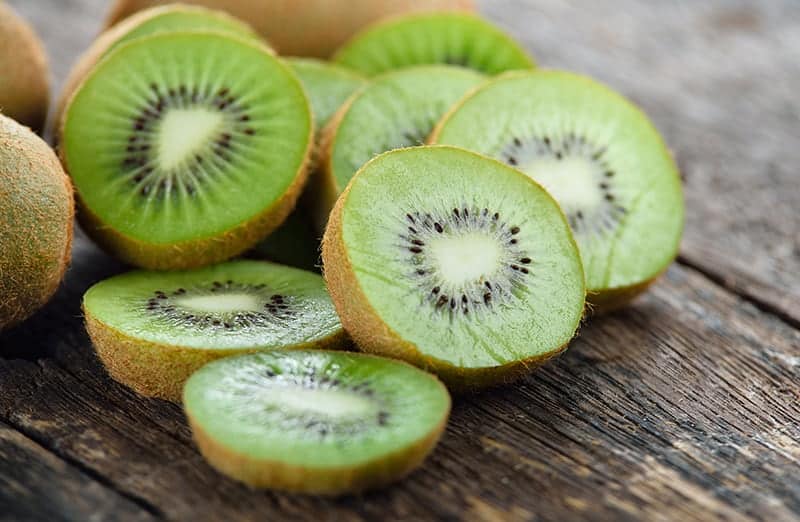
Kiwi Fruits
Growing kiwi is a long and complicated process that goes through many phases. It starts with choosing the right type of kiwi fruit – as there are three types – common, golden and kiwi berry.
Common kiwi seeds can be bought in a store.
After kiwiis already planted, even in perfect conditions many factors can endanger it, before it is fully grown. Kiwi may not have many insect enemies, so pesticides are unnecessary, but it can attract deer or cats that destroy it.
It is recommended to train kiwi shoots to grow on the support, by wiring vines to the trellis. Pruning must be done regularly, once a year by trimming excess canes and lateral shoots not supportable by provided trellis.
Kiwi plant flowers within five or four years from planting. Male plants have yellow pollen-covered anthers in the center of the flower. Kiwi fruit is produced only by female plants, and male plant pollinates every 8 or 9 of them.
To achieve optimal pollination, redundant males should be removed. Remaining male plants need to be spaced in the equal distance apart from females.
After a few years, kiwis will start producing fruit and become ready for harvesting!
What is time for the harvest?

Mature Kiwis
Time of the ripening depends on cultivar grown and given climate conditions. Commercially, the right moment is determined by the refractometer. Kiwi is mature and ready when its soluble sugars reach 6,5 notches on this measuring device.
Home growers start harvesting somewhere around first trough fifteenth November. By this time, the seed inside the fruit turns entirely black.
These plants require at least 240 frost-free days for their growing season. They can bear low temperatures to around 10 °C, but only if they are acclimated slowly. Late winter freezing temperatures may kill exposed buds.
How to harvest and store kiwifruits
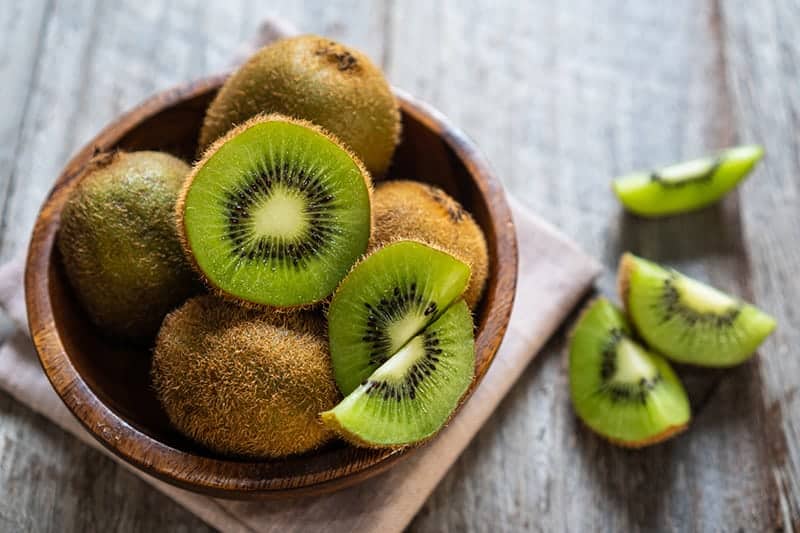
Fresh Kiwi Fruits
Harvesting kiwi fruit should be done with extreme care because they damage and bruise easily which limits their storage life. Harvesting process starts by snapping the stem at the fruit’s base. Larger fruits are harvested first, letting the smaller ones remain on the tree and retain appropriate size.
Cutting open the fruit should give the most accurate assessment of its ripeness, if the seeds are black, it is ready to be harvested.
After harvesting, kiwi should be placed in a bag and stored in the refrigerator, as soon as possible. Low temperatures between 0 and – 5 °C will freeze kiwis for up to six months. The lower the temperature is, longer the fruit will last.
Whenever it is needed, it can be taken out and placed in a plastic bag with apple or banana at ambient temperature for hosting the further ripening. This is the main reason why Kiwi should be stored away from other fruits which give off ethylene gas.
What are health benefits of kiwi?

Kiwi Slices
Kiwi fruits are small green health-bombs. They are full of antioxidants, fiber, vitamin C, vitamin E, vitamin K, folate, and potassium.
Because of their benefits they can help in treating asthma if consumed regularly. The high amount of fibers and actinidin in fruit may enhance protein digestion. As a great source of vitamin C, kiwi serves as good booster of the immune system, and it prevents flues and colds. Eating three kiwis a day should be helpful in slowing macular degeneration and protecting vision trough this process. Or you can also use kiwis to make detox tea for better health and smooth skin.
Bioactive substances in kiwi may aid in managing the blood pressure and reduce blood clotting. This way, consumption of kiwi fruit prevents numerous heart diseases.
However, some people show signs of kiwi allergy. Also, because of its blood clotting reduction abilities, kiwi shouldn’t be consumed before any surgeries or in the case of bleeding disorders.
Kiwi products that consumers like

Kiwi Products
- Kiwi powder – this product has all of the same nutrients as the fresh kiwi fruit. It is processed this way for faster transport and extending the keeping time. It can be mixed with other substances and dissolved in water. People commonly use it for making different food, sauces, desserts or syrup drinking.
- Kiwi oil – comes from kiwi seeds. It is best known for its effects in skin and hair care. It can be used for lightening the skin tone, dealing with acnes, eczema, and psoriasis or rough and dry hair, preventing premature aging, graying and hair loss.
Apparently, three kiwis a day are a recipe for solving many of your problems.
Cinnamon

Cinnamon Tree
Sprinkled on toast and lattes, or used in cakes, creams, and spreads, cinnamon is one of the baker’s best friends.

“Cinnamon comes from the inner bark of the cinnamon tree, which can go up to 60 feet!”
Found and developed in Sri Lanka at first, this spice found its way to the traditional cuisines of the world through sailor ships. The tree of cinnamon (genus Cinnamomum) has the characteristic leaves, which are darker on top and lighter below. The cinnamon tree releases a familiar fragrance as well.
When and where are Cinnamon Trees Planted?

Bunch of Cinnamon Sticks
Even though it comes from the tropical area, cinnamon can be grown in many countries around the world. The only thing important is to supply temperature higher than 40 degrees Fahrenheit and enough lightning for it to flourish. The land has to be dry, and mixed with sand and perlite for optimal results. The most cinnamon-populated areas (besides native Sri Lanka, India, & Myanmar) are mainly in the southern hemisphere, and around thee quator.
The specific planting time isn’t specified, but the fact that cinnamon requires two to three years before harvesting and the climate and regional requirements provide enough info.
What is the cinnamon harvesting process? How many times is it harvested per year?

Cinnamon
The best period for cinnamon harvest is after the rain season, and it usually happens twice (sometimes three times) a year. The amount of rainfall and the soil fertility are main factors that impact the harvest.
The two to three years old trees are cut few inches of the ground. This process allows the multiple branchless and straight stems to go up. Every branch that is thicker than 2 cm in diameter is ready for harvest. The process relatively straightforward, but requires practice and patience. The outer bark of the tree is scraped off by special tools and left to dry in the sun for several days. Depending on the weather and the bark itself, you get the standard, familiar cinnamon sticks.
How is cinnamon used?

Cinnamon Powder and Cinnamon Sticks
The primary usage of cinnamon bark is as a spice, as a condiment and flavor-enhancing ingredient. One of the most utilized, yet not known ways is an ingredient of chocolate. Yes, cinnamon is usually a part of the chocolate cream and tables.
Speaking of culinary utilization, cinnamon is an active ingredient in numerous recipes. From every dessert recipe known to man, to coffee, liqueurs, savory dishes, pastries, traditional drinks like Christmas eggnog, and more.
Saffron

Saffron Field
Saffron is the world’s most expensive spice.
The spice called “The Red Gold” costs around $5 for one gram. The reason for this ridiculous price lies in the harvest; the spice is harvested by hand from the saffron crocus flower. To make just one ounce of saffron spice, over 4,500 crocus flowers has to be processed.
The method of harvest is done by hand since the ancient times. This exquisite spice is somewhere between sweet and bitter and requires a lot of manual labor and time. Usually handpicked and sorted by elderly women in villages, saffron is very demanding.
Why is it the most expensive spice?

Saffron Flowers On Field
Each saffron flower produces only three threads, which is separated by hand and sorted out for seasoning. The inside stigmas of the flower’s insides are usually colored between orange and red, and when dried, they are the foundation for the spice. The thing about harvesting is, that it happens only when the flower itself is opening.
Where is saffron planted mostly?

Harvesting Saffron Flowers
There are many saffron fields around the world, but the biggest areas of thee xploit are in India, Spain, Greece, Azerbaijan, China, Egypt, and Italy. The plant requires mild weather, and fertile, soft soil for flourishing. The usual planting period is from June to mid-September, and the flower is usually blossoming during October of the following year.
What is Saffron good for?

Saffron Flower And Dried Saffron Spice
The spice is very distinctive and requires proper usage. The Spanish Paella Valenciana is the first association when saffron is mentioned, and there’s no mistake about that. Many Italian meals utilize the saffron’s distinctive flavor and aroma, pushing the risotto to a whole new level. Next, several alcoholic beverages contain saffron, providing that both sweet and bitter aroma. Nordic continent cuisine implemented saffron in dough buns, creating a sweet pastry tingles the senses and provokes taste buds in your mouth.
Nutrition-based, saffron is the world’s biggest manganese container. It delivers mind-blowing 400% of required daily intake (based on a 2000 calorie diet). Next, there are Vitamin C, Magnesium, Iron, Potassium, Vitamin B6, and more. The spice regulates your blood sugar, levels your hormones, helps with calcium and carbohydrates absorption. All in all, this spice is top of the line when we talk about health benefits. So, there’s more reason to have it in your diet.
Saffron must be soaked in hot (not boiling) water for several hours before culinary use. It will release the red-ish color and healthy nutrients, get a bit softer.

“Because its strong color, saffron is used as a dye for textile. Buddhist monks’ robes are colored into orange by saffron.”
How to recognize the real saffron compared to the low-quality one?

Saffron Spice
When buying saffron, you have to look carefully into details, because you can get scammed easily. For a spice that goes $500 for 100 grams, you’d better watch out!
First of all, broken threads are the best, and the easiest sign that you’re looking at the bad product. Next, there are unusually long threads, with somewhat unnatural color. After getting to know a decent saffron thread gets easier with time. When you’ve seen more than five, you’ll be able to distinct the right ones. The best feature to identify a genuine saffron is the trumpet-like end.
Scammers usually use colored corn husk, which can look surprisingly deceiving to tourists in areas like India. Coconut fibers are the next most common materials used to deceive tourists and shoppers. When you’re suspicious about the saffron offered, ask to taste one thread. It shouldn’t be bland nor sweet, but instead the saffron should taste somewhat pungent.
Wasabi

Wasabi Horseradishes
A traditional spice in Japan, Wasabi is truly something else. If you haven’t tasted it yet, don’t let the light green color fool you – this thing will burn your tongue and throat if you’re not careful!
What is wasabi? How it’s made?
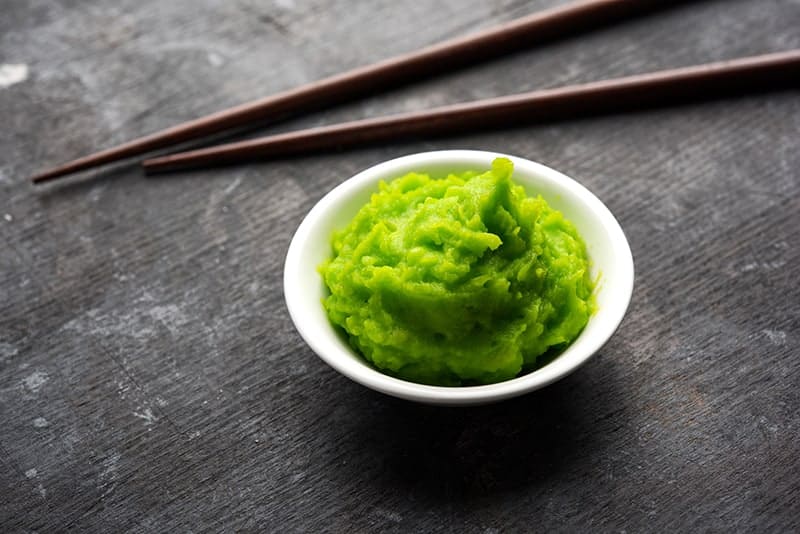
Wasabi Horseradish
The plant wasabi (Wasabia Japonica) is native to Japan, and it spreads all across the country’s river valleys and mountain areas with northern climate. Speaking of that, the plant requires cold temperatures, wet conditions, and shade. The plant grows slowly throughout the year, spreading thick stem, long petioles, and large leaves. The whole plant is utilized in processing, but its recognizable, adamant taste and aroma are concentrated in the root the most.
The root is smashed or grated into tiny bits and processed with other ingredients to create the wasabi paste or wasabi powder. The ingredients usually include horseradish, mustard, and even some species of cabbage. The reason for this mixture and not pure wasabi lies in the supply and demand. The genuine wasabi can be found only in Japan, and the demand for wasabi makes it really hard to get.
Therefore, manufacturers are trying to supply it by spreading the ingredients and using more available alternatives to create wasabi. The thing is, the majority of sushi places that offer wasabi in the US usually serve colored horseradish. The climate and geographic dependency of this plant made it almost impossible to cultivate outside the island of Japan, and therefore limiting its production.
What is the special flavor of wasabi that attracts people?
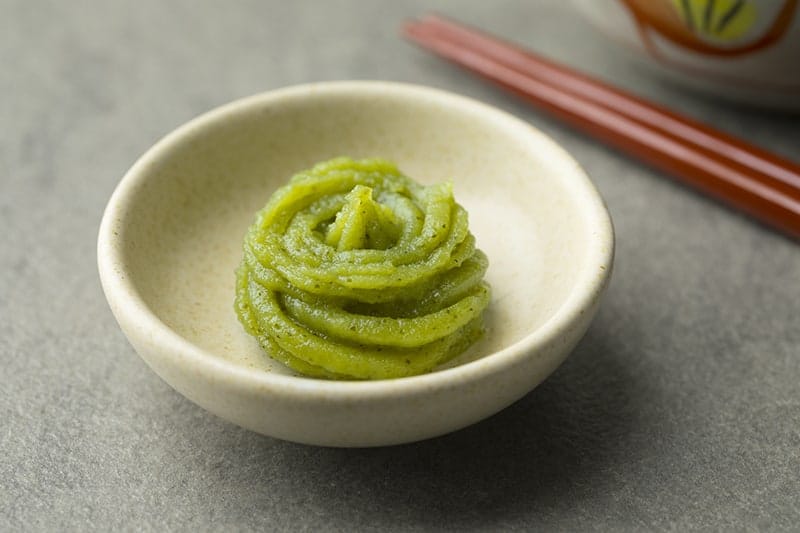
Wasabi On Plate
The taste of wasabi is many times connected with and described as horseradish, so I’ll explain the wasabi’s aroma & flavor the best if I compare it with horseradish. If you haven’t tried both, the chance is that you wouldn’t differentiate the two even after several tasting sessions.
Horseradish is strong, intense, and very strong, while wasabi follows these adjectives but brings a dose of earthy, organic taste and better texture, finer details in the taste. With wasabi, you can sense the uniqueness and somewhat coldness of the plant’s essence, while with horseradish, you get that strong spicy taste.
Wasabi is unique, hard to get, and attacks your taste buds a bit more subtly than horseradish. The two first facts about wasabi are enough to attract people and stimulate the market demands (and pump up the prices), but the earthy, cold and subtle details that wasabi brings are the ones that make it so distinctive and favorable.
How many types of Wasabi?

Wasabi Liquid
As a product, wasabi comes in four forms: as a stem, grated stem, dried powder, or liquid paste. When you hear “Wasabi,” an average Joe will probably think of the liquid paste form, as it is the most spread one. Depending on the occasion and the place where you’re getting it, wasabi can be served in all forms except the stem.
The characteristic taste of wasabi is usually contained in the powder the most, and in finely grated stem the second. The thing about the latter is that you need to hit the designated time frame to serve/consume it to acquire the perfect flavor. That’s why wasabi is either in liquid paste or powder form.
Depending on the type of wasabi you’re getting, the price will vary. For example, the genuine Wasabi stem will be tough to find, and it will cost significantly. Asian fruit and vegetable stores might have it occasionally, but it’s not a mission impossible to get it. The wasabi products are more available on the market, but you’ll have a difference in uniqueness and quality.
What are the popular dishes with wasabi?

Wasabi And Sashimi
This exotic spice is utilized in many cuisines and different dishes, but the first association is always sushi. The most recognizable Japanese dish in the world, raw fish and rice combined with various plants, soy sauce and wasabi are simply something that you shouldn’t miss.
Still, there are many more meals that utilize wasabi, and I’ll mention some of them right now:
- Soba Noodles – One of the very popular and most frequent meals in the Japanese cuisine. It brought wasabi into the cuisine as one of the most important flavor ingredients. The noodles match with wasabi greatly, and the ease of preparation and numerous possibilities really stand up for its popularity.
- Sashimi – Sashimi is something similar to sushi, yet it has some differences. The wasabi’s raw and strong aroma combines perfectly with raw fish, vegetables, and other types of raw meat. Sashimi is even more popular in Japan than sushi.
- Wasabi Peas – Here’s an interesting, yet very popular combination; you take regular green peas, and coat them with a bit of starch, salt, oil, sugar, and wasabi. These small snacks are healthy, but the strong taste and aroma might numb your tongue.
Banana

Bananas Plant
There are no people in this world who doesn’t know about this tropical fruit. The shape and bright yellow color distinguish banana on the fruit specter easy; there are not much similar fruits out there

“The banana is a perennial plant, which means it replaces itself.”
When and where is banana planted?

Bunches of Bananas
The banana’s tree is specific since its fruit doesn’t come from seed but from a bulb. The planting time can vary throughout the world because banana can be cultivated almost anywhere in the tropical regions. It requires a moist soil though, so the cultivation requires a substantial amount of watering if cultivated artificially.
There is only one harvest in a banana’s life. After that harvest, the tree doesn’t breed new fruit.
The sun is paramount to the tree, and many countries around the world can fulfill the requirements for cultivating bananas.
How many types of banana is in the world?
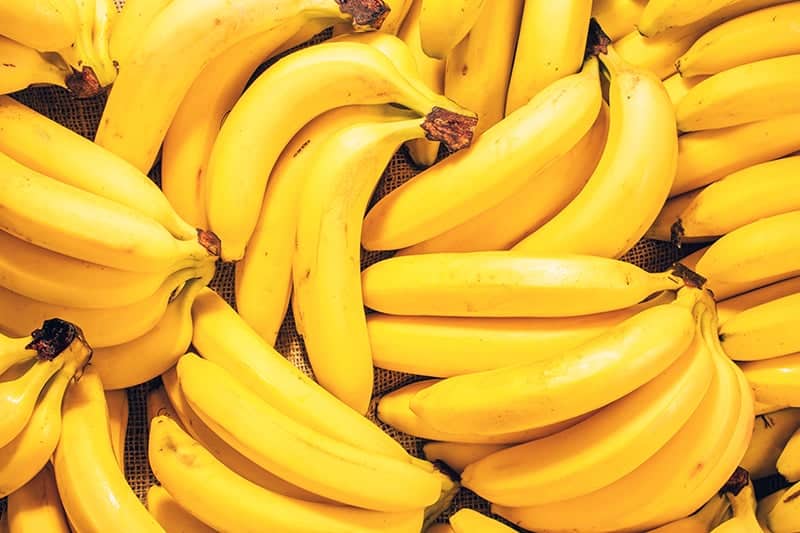
Bunch of Ripening Bananas
There are over a thousand of varieties and types of bananas known today. This big number is reached by cultivating on different geographical areas, ways of breeding, and processing. The types of bananas are split into 50 groups, and the most common banana in the world is Cavendish.
What are the reasons to eat bananas?
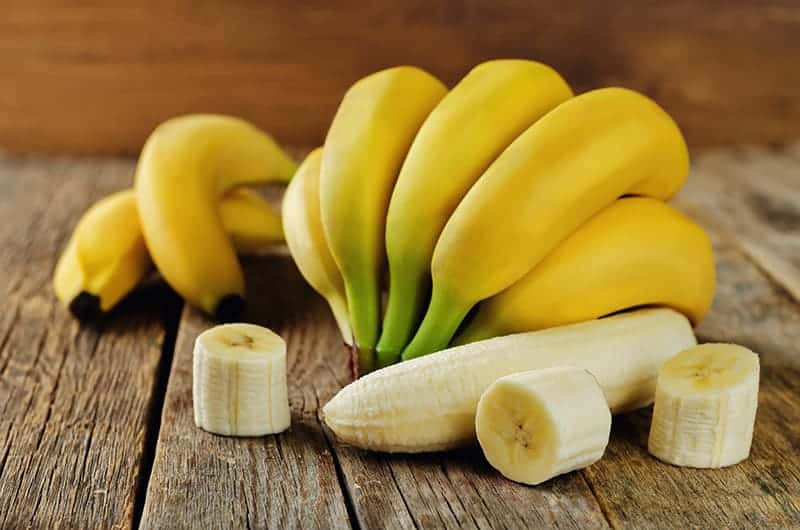
Bunch of Ripening Bananas
First of all, they are delicious! Second, bananas are very healthy, and supply several important nutrients to the body, which support digestion, weight loss, and improve heart condition. A significant amount of fiber, antioxidants and vitamin B6 alongside low calories (around 100 calories for a single banana) set banana high on the healthy diet supplies.
They are excellent in weight loss diets because they make you full because of resistant starch they contain. This substance has appetite-reducing effects and helps you not crave food on a diet. Furthermore, resistant starch helps with insulin sensitivity, enabling more controlled blood glucose and stimulated fat loss.
Bananas provide a significant energy boost, making them efficient in athlete nutrition, and overall fitness-oriented nutrition in the average person. Bananas are easy to get, available almost anywhere, and affordable.
Can anybody eat bananas? Are there people who shouldn’t eat them?
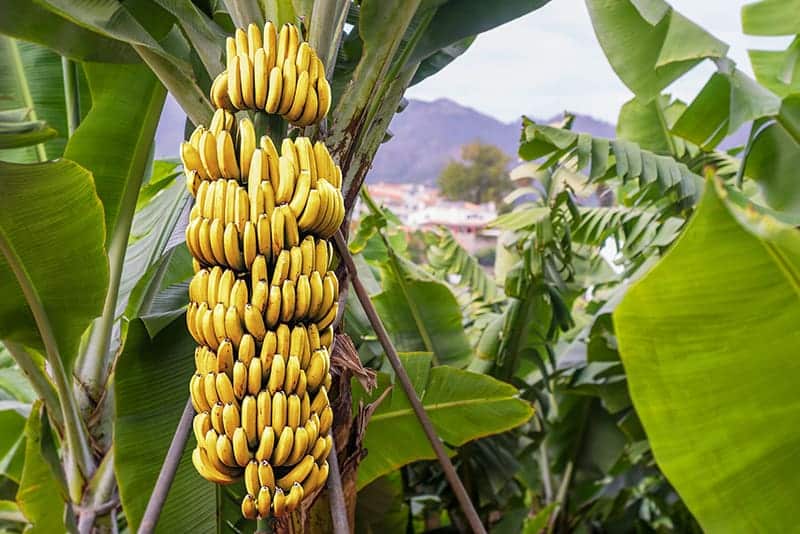
Ripe Bananas
Since banana is stacked with sugar and starch, it’s not advised for diabetes patients. There have been studies about bananas in general and in correlation with diabetics. The answer to this question is – people with diabetes can eat bananas, but be careful with the ripeness of the fruit. It’s better to eat greener bananas to avoid extra sugar and starch.
Basically, anyone can eat bananas, since they are very healthy and delicious food. But, like every other fruit, they are stacked with sugar, and you should be careful in the timing when you consume them, and the amount, of course.
Here are some tasty recipes that utilize the banana

Peanut Butter Banana Oat Smoothie
- Bananas go great with peanut butter. If you’re using organic peanut butter, check whether the peanut butter has gone bad before using!
- The banana split is not advisable if you’re on a diet, but this recipe from Taste is truly something else. Very easy to make, and splendid to eat.
- Next, the Extra Special Banana Pudding from VJANE at All Recipes is something definitely worth trying. Four simple steps, and voila!
- The Healthy Banana Bread from Ms. Chinmayie on lovefoodeat.com is great – no oil or sugar is included in the recipe. Check it out and try it, it’s delicious!
- Another worthy addition to the list would be Fat-Free Vegan Eggnog from Lindsay S. Nixon on HappyHerbivore. You just need fat-free milk (soymilk preferred), one whole frozen banana, a bit of nutmeg, cinnamon and cloves.
- Ms. Dana from Minimalist Baker makes an astounding RAW VEGAN BANANA CREAM PIE, which is a great addition to the list.
- Next, there are Baked Banana Chips from Ms. Laura of Momables.com, which are really easy to make, yet very delicious and useful.
- Bananas quickly get overripe, so you have to be either careful or smart. Here are dozens of ideas to utilize bananas in your kitchen: BuzzFeed’s 17 Delicious Ways To Use Up Old Bananas, Huff Post’s 21 Delicious Recipes To Make With Overripe Bananas, Food Network’s 70 Brilliant Ways to Use Overripe Bananas.
Food definitely doesn’t look like you’ve expected?

I was stunned to see some of these images too.
They really changed the way I observe and think of some of my favorite food.
Let me know what you think in the comments below!

